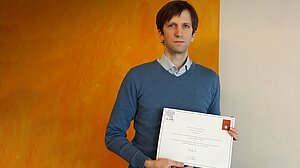February 22, 2021
The Fraunhofer Heinrich Hertz Institute (HHI) researchers Dr. Wojciech Samek and Dr. Sebastian Lapuschkin together with Dr. Grégoire Montavon and Prof. Klaus-Robert Müller (TU Berlin) as well as Prof. Alexander Binder (University of Oslo) have jointly received the 2020 "Pattern Recognition Best Paper Award" and "Pattern Recognition Medal”. The international scientific journal Pattern Recognition awards the prize annually to highlight papers that have accomplished an outstanding impact on their respective research field. The award committee honored the researchers for their 2017 publication "Explaining Nonlinear Classification Decisions with Deep Taylor Decomposition" for its influence on the field of machine learning.
The award winners were announced during the virtual International Conference on Pattern Recognition (ICPR) on January 15, 2021. The "Pattern Recognition Best Paper Award" is granted every two years. The publication recognizes the best scientific paper published in the journal within a certain time period. Pattern Recognition addresses pattern recognition and its fields of application such as image processing, computer vision, and biometrics.
"We are very proud to receive this award and thus for our work to be highlighted within the scientific community," comments Dr. Wojciech Samek, head of the department Artificial Intelligence at Fraunhofer HHI. "As of January 2021, our paper has been cited 557 times according to Google Scholar. Thomson Reuters' ‘Essential Science Indicators’ has rated our contribution as a ‘highly cited paper’. Based on this information, our paper is currently ranked at the top percent of the most cited scientific papers in the engineering field. We are very excited that our research has received this huge worldwide recognition."
The mentioned paper addresses the so-called black box problem. Machine learning methods, in particular deep learning, successfully solve a variety of tasks. However, in most cases they come with the disadvantage of not providing the information that has led to a particular decision. The paper proposes a general solution to the problem of understanding classification decisions. It uses pixel-by-pixel decomposition of nonlinear classifications and evaluates the procedure in different scenarios. With this, it was possible to provide a theoretical framework for explainable AI (XAI) that is applicable in many areas.
You can find the Paper here .
